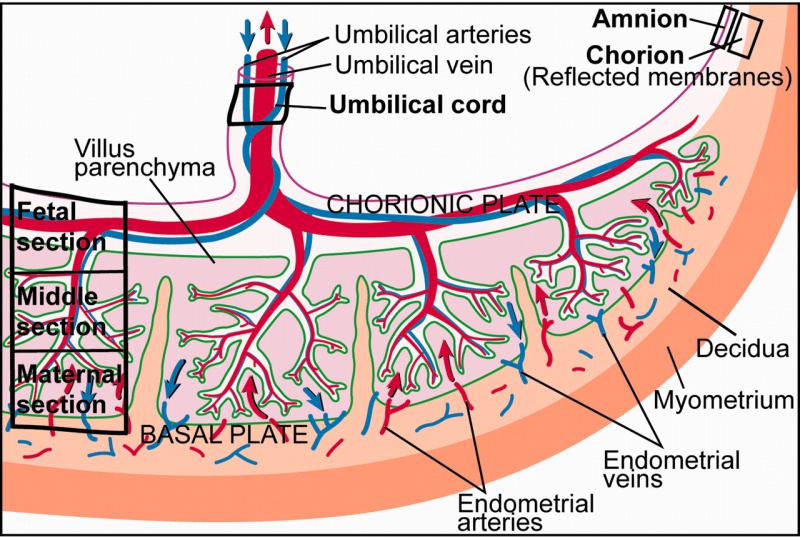File:Placenta cartoon.jpg
From Embryology

Size of this preview: 800 × 537 pixels. Other resolution: 1,280 × 859 pixels.
Original file (1,280 × 859 pixels, file size: 334 KB, MIME type: image/jpeg)
Placenta Cartoon
Cartoon showing an overview of the structural organization of the placenta and fetal membranes.
- "The placenta is a composite organ of trophectoderm-derived cells and cells that are derived from the inner cell mass (ICM)/epiblast, and a minor component comes from the mother in the form of her blood. The ICM/epiblast-derived components are the amnion, the umbilical cord, and the mesodermal components of the chorion. The amnion and chorion that line the amniotic cavity are incompletely fused, and together, they are called “reflected membranes;” the amnion and chorion that line the placental disk proper are called chorionic plate. The amnion is embryologically continuous with the epithelium of the umbilical cord, where it firmly fuses during development and cannot be dislodged. The amnion is composed of a layer of epithelial cells resting on a basement membrane over a thin layer of connective tissue. The chorion is juxtaposed with chorionic connective tissue and at term includes atrophied remnants of villi and associated fetal blood vessels. The chorion is interdigitated with maternal decidua and its associated blood vessels. The umbilical cord consists of an amniotic epithelium, two arteries, and one vein embedded in a matrix called Wharton’s Jelly. The villus parenchyma makes up most of the placenta and consists of 40–60 trophoblast villi. The trophoblastic villus is the functional unit of placenta where diffusion and active transport of nutrients and waste products takes place. The maternal side of villus parenchyma includes a thin basal plate corresponding to the maternofetal junction. The basal plate is made up of trophoblasts, interposed fibrinoid, and the endometrial components (stromal and fibroblast-like cells, as well as some macrophages, veins, and arteries)." (text from reference)
- Links: Placenta Development
Reference
<pubmed>16567644</pubmed>| Proc Natl Acad Sci U S A.
Copyright
Proceedings National Academy of Sciences (PNAS) Liberalization of PNAS copyright policy: Noncommercial use freely allowed Note original Author should be contacted for permission to reuse for Educational purposes. See also PNAS Author Rights and Permission FAQs
- Cozzarelli NR, Fulton KR, Sullenberger DM. Liberalization of PNAS copyright policy: noncommercial use freely allowed. Proc Natl Acad Sci U S A. 2004 Aug 24;101(34):12399. PMID15314225 "Our guiding principle is that, while PNAS retains copyright, anyone can make noncommercial use of work in PNAS without asking our permission, provided that the original source is cited."
File history
Click on a date/time to view the file as it appeared at that time.
| Date/Time | Thumbnail | Dimensions | User | Comment | |
|---|---|---|---|---|---|
| current | 11:00, 5 May 2013 |  | 1,280 × 859 (334 KB) | Z8600021 (talk | contribs) | ==Placenta Cartoon== ===Reference=== {{PNAS}} |
You cannot overwrite this file.
File usage
The following page uses this file: